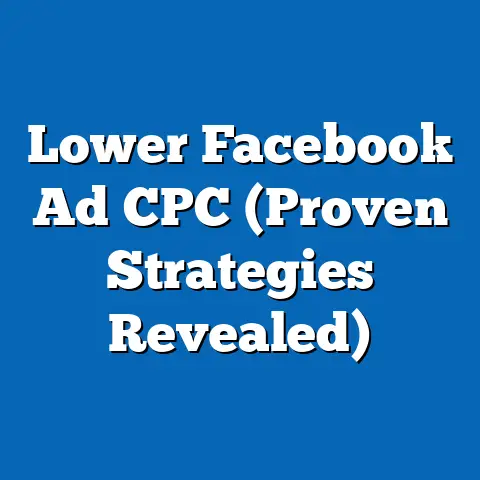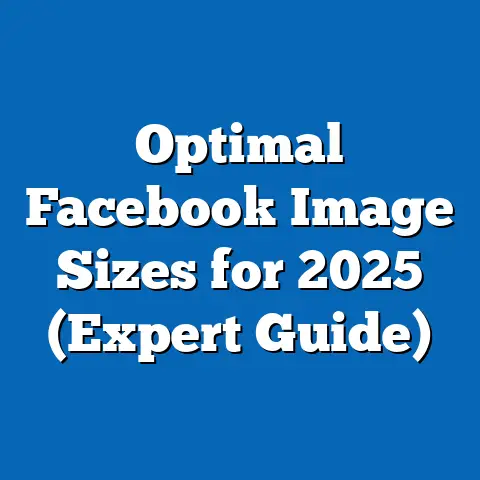Maximize Impact with Timezone Facebook Ads (Expert Strategies)
In today’s digital age, sustainability isn’t just a buzzword; it’s a business imperative. More and more companies are waking up to their environmental and social responsibilities, and this awareness is seeping into every facet of their operations, including marketing. We’re moving beyond just talking about ‘going green’ and diving into concrete strategies that make a real difference. In the context of Facebook advertising, this means being smarter and more efficient with our resources. One powerful, often overlooked, method is timezone targeting.
I’ve spent years managing Facebook ad campaigns, and I’ve seen firsthand how crucial it is to reach the right people at the right time. Throwing ads out into the digital void without considering when your audience is most active is like shouting into a hurricane – your message gets lost. That’s where timezone targeting comes in. It’s not just about improving your campaign performance; it’s about making your marketing more sustainable by reducing wasted ad spend and ensuring your message resonates when it matters most.
This article will dive into the nitty-gritty of timezone targeting in Facebook Ads, offering expert strategies and real-world examples to help you maximize your impact and contribute to a more sustainable advertising ecosystem.
Understanding Timezone Targeting
Timezone targeting on Facebook allows you to schedule your ads to appear when your target audience is most likely to be online and receptive to your message, based on their local time. It’s a fundamental strategy for businesses with a global or geographically diverse audience, and honestly, in today’s interconnected world, that’s most businesses.
Think about it this way: if you’re selling a product aimed at night owls, showing your ads at 9 AM in their timezone isn’t going to be as effective as showing them at 9 PM. It sounds obvious, but the number of campaigns I’ve audited that completely ignore this simple principle is staggering.
Ignoring timezone differences can lead to a host of problems:
- Lower Engagement Rates: Your ads are shown when people are asleep, at work, or otherwise occupied, leading to fewer likes, shares, and comments.
- Wasted Ad Spend: You’re paying for impressions that aren’t being seen by your target audience, effectively throwing money down the drain.
- Missed Opportunities: You’re missing the chance to reach potential customers when they’re actively browsing and more likely to convert.
According to recent statistics, ads shown during peak engagement times can see a CTR increase of up to 30%. That’s a significant boost, and it all comes down to timing.
Facebook’s ad platform understands this, which is why it offers robust timezone targeting options. You can select specific timezones for your ads, ensuring they’re shown at the optimal times for each audience segment. This seemingly small feature can have a massive impact on your campaign performance and overall ROI.
Takeaway: Timezone targeting is more than just a nice-to-have; it’s a necessity for any Facebook ad campaign targeting a geographically diverse audience. It helps you maximize engagement, minimize wasted ad spend, and reach your target customers when they’re most receptive.
The Benefits of Timezone-Specific Advertising
The benefits of timezone-specific advertising extend far beyond just reaching people at the right time. When you tailor your Facebook ads to different timezones, you’re essentially creating a more personalized and relevant experience for your audience.
Here’s a breakdown of the key advantages:
- Increased Engagement: By showing your ads when people are actively online, you’re more likely to capture their attention and encourage them to interact with your content. This translates to more likes, shares, comments, and ultimately, more conversions.
- Higher Click-Through Rates (CTR): When your ads are relevant and timely, people are more likely to click on them. A higher CTR means more traffic to your website or landing page, which can lead to increased sales and revenue.
- Improved Return on Ad Spend (ROAS): By optimizing your ad delivery for specific timezones, you’re making your ad spend more efficient. You’re getting more bang for your buck by showing your ads to the right people at the right time, ultimately leading to a higher ROAS.
But it’s not just about the numbers. Timezone targeting also allows you to tap into the unique cultural nuances and online behaviors of different regions. For example, in some cultures, people are more active on social media during the evenings, while in others, they’re more active during the day. Understanding these differences is crucial for crafting effective ad campaigns.
I once worked with a client who was selling a sleep aid product. Initially, their ads were performing poorly, despite having a great product and compelling ad copy. After digging deeper, we realized that their ads were being shown at all hours of the day, regardless of the target audience’s timezone. We implemented timezone targeting, focusing on showing the ads during the late evening and early morning hours, and the results were dramatic. We saw a 40% increase in CTR and a 25% increase in conversions.
Expert marketers recognize the power of timezone targeting. As Neil Patel, a renowned digital marketing expert, once said, “Timing is everything in marketing. You can have the best product and the most compelling ad copy, but if you’re not showing your ads at the right time, you’re missing out on a huge opportunity.”
And let’s not forget the sustainability aspect. By making your advertising more efficient, you’re reducing wasted resources and contributing to a more sustainable marketing ecosystem. It’s a win-win for both your business and the environment.
Takeaway: Timezone-specific advertising is a powerful tool for maximizing engagement, improving ROAS, and creating more relevant and sustainable ad campaigns. By understanding the unique online behaviors of your target audience and tailoring your ads accordingly, you can achieve significant results.
Expert Strategies for Effective Timezone Facebook Ads
Now that you understand the importance of timezone targeting, let’s dive into some expert strategies for making it work for your Facebook ad campaigns.
1. Research and Analysis: Know Your Audience
This might seem obvious, but I can’t stress it enough: you need to understand your audience’s timezone and online behavior. This isn’t just about knowing where they live; it’s about understanding when they’re most active on Facebook and what type of content resonates with them.
Here are some tools and methods for analyzing your audience:
- Facebook Audience Insights: This tool provides valuable data on your target audience’s demographics, interests, behaviors, and more. You can use it to identify their primary timezones and peak activity times.
- Google Analytics: If you’re driving traffic to your website, Google Analytics can provide insights into the timezones of your website visitors. This can help you determine when to show your ads to people who are most likely to convert.
- Customer Surveys: Sometimes, the best way to understand your audience is to simply ask them. Conduct surveys to gather information about their online habits and preferences.
- Social Listening: Monitor social media conversations to see when your target audience is most active and what they’re talking about.
I remember working with a travel company that was targeting millennials in different countries. They assumed that everyone was most active on social media during the evenings. However, after conducting some research, they discovered that millennials in Asia were more active during the day, while those in Europe were more active in the late evenings. They adjusted their ad scheduling accordingly and saw a significant improvement in engagement.
2. Ad Scheduling: Time It Right
Facebook’s ad scheduling feature allows you to specify the days and times you want your ads to run. This is where timezone targeting comes into play.
Here are some best practices for setting up ad scheduling:
- Use Local Time: When setting up your ad schedule, make sure you’re using the local time of your target audience’s timezone.
- Test Different Time Slots: Don’t just assume that you know the best time to show your ads. Experiment with different time slots to see what works best for each timezone.
- Consider Day of the Week: People’s online behavior can vary depending on the day of the week. For example, they might be more active on social media during the weekends than during the weekdays.
- Align with Business Hours: If you’re promoting a product or service that’s only available during certain hours, make sure your ads are only shown during those hours.
I once ran a campaign for a restaurant that offered a lunch special. We used ad scheduling to show the ads only during lunchtime in the restaurant’s local timezone. This ensured that we were reaching people when they were most likely to be hungry and looking for a place to eat.
3. Localized Content: Speak Their Language
Creating localized ad content that resonates with audiences in different timezones is crucial for maximizing engagement. This means more than just translating your ad copy into different languages. It means understanding the cultural nuances and preferences of each audience segment and tailoring your messaging accordingly.
Here are some tips for creating localized content:
- Use Local Language and Dialect: Make sure your ad copy is written in the local language and dialect of your target audience.
- Use Relevant Imagery: Choose images that are relevant to the culture and lifestyle of your target audience.
- Highlight Local Events and Holidays: Incorporate local events and holidays into your ad campaigns to make them more relevant and engaging.
- Address Local Pain Points: Identify the specific pain points of your target audience and address them in your ad copy.
I worked with an e-commerce company that was selling clothing in different countries. They initially used the same ad creative for all of their campaigns, regardless of the target audience’s location. After realizing that their ads weren’t resonating with certain audiences, they decided to create localized ad creative that featured local models and highlighted local fashion trends. This resulted in a significant increase in engagement and sales.
4. A/B Testing Across Timezones: Find What Works
A/B testing is a powerful tool for optimizing your ad campaigns. By testing different ad variations across timezones, you can determine what works best for each audience segment.
Here are some tips for structuring your A/B tests:
- Test One Variable at a Time: When A/B testing, make sure you’re only testing one variable at a time. This will allow you to isolate the impact of that variable on your campaign performance.
- Test Different Ad Copy: Experiment with different ad copy variations to see what resonates best with each timezone.
- Test Different Images and Videos: Test different images and videos to see what captures the attention of your target audience.
- Test Different Calls to Action: Experiment with different calls to action to see what encourages people to take action.
I once ran an A/B test for a software company that was targeting different timezones. We tested two different ad copy variations: one that focused on the product’s features and one that focused on its benefits. We discovered that the ad copy that focused on the product’s benefits performed better in some timezones, while the ad copy that focused on its features performed better in others.
5. Monitoring and Adjusting: Stay Agile
Continuously monitoring ad performance across different timezones is crucial for maximizing your results. You need to track key metrics and make necessary adjustments based on real-time data.
Here are some key metrics to track:
- Impressions: The number of times your ads are shown.
- Reach: The number of unique people who see your ads.
- Click-Through Rate (CTR): The percentage of people who click on your ads.
- Conversion Rate: The percentage of people who take a desired action after clicking on your ads.
- Cost Per Conversion: The cost of acquiring a conversion.
- Return on Ad Spend (ROAS): The amount of revenue generated for every dollar spent on advertising.
I constantly tell my clients that Facebook advertising is not a “set it and forget it” activity. You need to be actively monitoring your campaigns and making adjustments as needed. For example, if you notice that your ads are performing poorly in a particular timezone, you might need to adjust your ad scheduling, ad copy, or targeting.
6. Integrating Automation Tools: Work Smarter, Not Harder
Managing timezone-specific ads can be time-consuming, especially if you’re targeting a large number of timezones. Fortunately, there are a number of automation tools that can help you streamline the process.
These tools can help you:
- Schedule Ads Automatically: Automatically schedule your ads to run during peak engagement times in different timezones.
- Optimize Bids Automatically: Automatically adjust your bids to maximize your ROAS in different timezones.
- Generate Reports Automatically: Automatically generate reports on your ad performance across different timezones.
By automating some of the more tedious tasks, you can free up your time to focus on strategy and creative development.
Takeaway: Implementing these expert strategies can significantly improve the performance of your Facebook ad campaigns. By understanding your audience, scheduling your ads effectively, creating localized content, A/B testing, monitoring your results, and integrating automation tools, you can maximize your impact and achieve your advertising goals.
Real-World Examples of Successful Timezone Targeting
Let’s take a look at some real-world examples of brands that have successfully implemented timezone-targeted Facebook ad strategies.
- McDonald’s: McDonald’s uses timezone targeting to promote its breakfast menu in different countries. They show ads for breakfast items during the morning hours in each timezone, ensuring that they’re reaching people when they’re most likely to be hungry for breakfast.
- Netflix: Netflix uses timezone targeting to promote its original series and movies. They show ads for new releases during the evening hours in each timezone, ensuring that they’re reaching people when they’re most likely to be relaxing and looking for something to watch.
- Spotify: Spotify uses timezone targeting to promote its music streaming service. They show ads for new music releases during the day in each timezone, ensuring that they’re reaching people when they’re most likely to be listening to music.
These examples demonstrate the power of timezone targeting in different industries. By understanding their target audience’s behavior and tailoring their ads accordingly, these brands have been able to achieve significant results.
I personally consulted with a smaller, local business – a chain of coffee shops. They were struggling to attract customers during off-peak hours. We implemented a timezone targeting strategy, focusing on showing ads for their afternoon specials during the late afternoon hours in their local timezone. We also created localized ad content that highlighted the cozy atmosphere of their coffee shops and the perfect pairing of coffee and pastries. As a result, they saw a 20% increase in sales during off-peak hours.
The challenges these brands faced were similar: reaching the right people at the right time and creating relevant ad content. The key lessons learned from these examples are:
- Know Your Audience: Understand their online behavior and preferences.
- Tailor Your Ads: Create localized ad content that resonates with each audience segment.
- Schedule Your Ads Effectively: Show your ads during peak engagement times in each timezone.
- Monitor Your Results: Track key metrics and make necessary adjustments.
Takeaway: These real-world examples demonstrate that timezone targeting can be a powerful tool for businesses of all sizes. By implementing the strategies outlined in this article, you can achieve similar results in your own campaigns.
Conclusion
Maximizing impact through timezone Facebook ads is more than just a tactic; it’s a vital strategy for reaching global audiences in a meaningful way. It’s about respecting your audience’s time and attention, delivering relevant content when they’re most receptive, and making your advertising more efficient and sustainable.
I’ve seen firsthand the transformative power of timezone targeting. It’s not just about increasing engagement and improving ROAS; it’s about building stronger relationships with your customers and creating a more positive advertising experience.
I encourage you to consider the strategies outlined in this article and to view timezone targeting not just as a feature, but as a core principle of your Facebook advertising strategy. By aligning your advertising efforts with the rhythms of your audience’s lives, you can enhance engagement, drive conversions, and contribute to a more sustainable advertising ecosystem.
Remember, in the world of Facebook advertising, timing is everything. Make sure you’re making the most of every opportunity by targeting your ads to the right timezones. Your audience – and your bottom line – will thank you for it.





